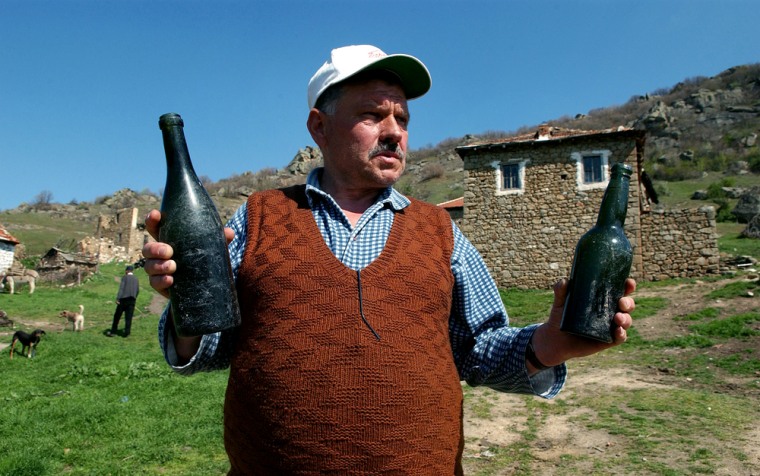French adjutant-chief Eugene Rouges died with several of his men here when a German artillery shell exploded in their trench on Nov. 16, 1916.
But their spirits live on in Gradesnica.
More than 90 years later, visitors are still drawn to this former World War I battlefield, a remote mountain village in southern Macedonia, where the lure is more than military history: A liquid fortune in vintage cognac and wine lies buried in the old trenches.
Stefan Kovacevski, 64, is among residents who tasted the French army rations that have matured into an exquisite elixir.
“At first we were afraid to taste the dark, thick liquid,” he said. “But ... this must be what people mean by the nectar of the gods.”
$7,000 per bottle
Villagers unearthed the first case of 15 bottles about 15 years ago. Since then, digs have yielded several cognac caches, usually of about two dozen bottles each. Some have been found by farmers plowing fields, and at least two batches came to light after a glint in the sand of an old trench caught a villager’s eye.
The old-fashioned cognac bottles can fetch up to nearly $7,000 from collectors, according to Mihail Petkov, professor of viticulture and oenology at Skopje University.
“I never had a chance to taste something like that,” he said. “What the villagers drank was probably a cognac, not a wine. The wines were intended to be consumed immediately ... and not to last for a long period of time.”
“But with cognac the situation is different,” Petkov said. “The older, the better.”
Wine-producers in France were obliged to prepare certain amounts of wine and spirits especially for the army.
'Forgotten by all'
Gradesnica lies in the heart of the Mariovo region, near the border with Greece, 125 miles south of the Macedonian capital, Skopje. There is no asphalt road, and during the harsh winters the village is cut off from the rest of the world. Only army vehicles can get through with necessary supplies.
“This is probably the most beautiful part of the country, forgotten by all,” said Dano Popovski, 64, owner of the village’s only shop.
But in 1916, Gradesnica was at the heart of the fighting, during a drive by Allied forces to support Serbia and stop the advance of Axis troops.
“On this side were Germans and Bulgarians. On the other side of the front line were the French and their Serbian allies,” said Najdo Koleskovski, 56.
He said it was in the nearby village of Gruniste, where he lives, that villagers unearthed the first case of 15 bottles. Holding up three empty bottles of wine and cognac, he reminisced about how he and three friends drank enjoyed every one.
“It was the best drink I ever had in my life,” he said.
'Nothing tastes better'
Gruniste, without electricity and home to four cattle farmers, lies on what was the French side of the front.
Villagers say foreigners — including many French — are scouring the area for cognac, maps in hand. None of the villagers said they had sold any of the bottles.
“Nothing tastes better, and that is why the French come here,” said Petar Sindevski, 73, from the nearby village of Staravina.
“There must be a lot of stocks of cognac or wine buried in this area,” he said. “It is a real treasure.”
